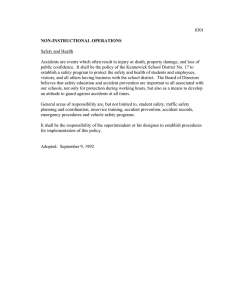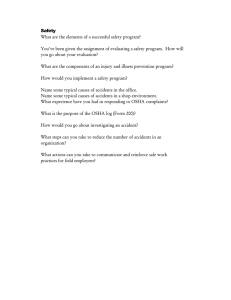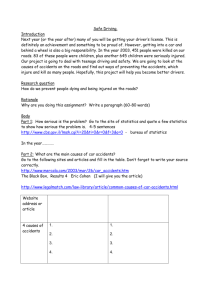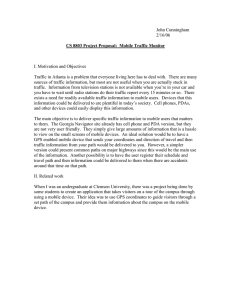IRJET- A Review Study on Road Accident in India
advertisement
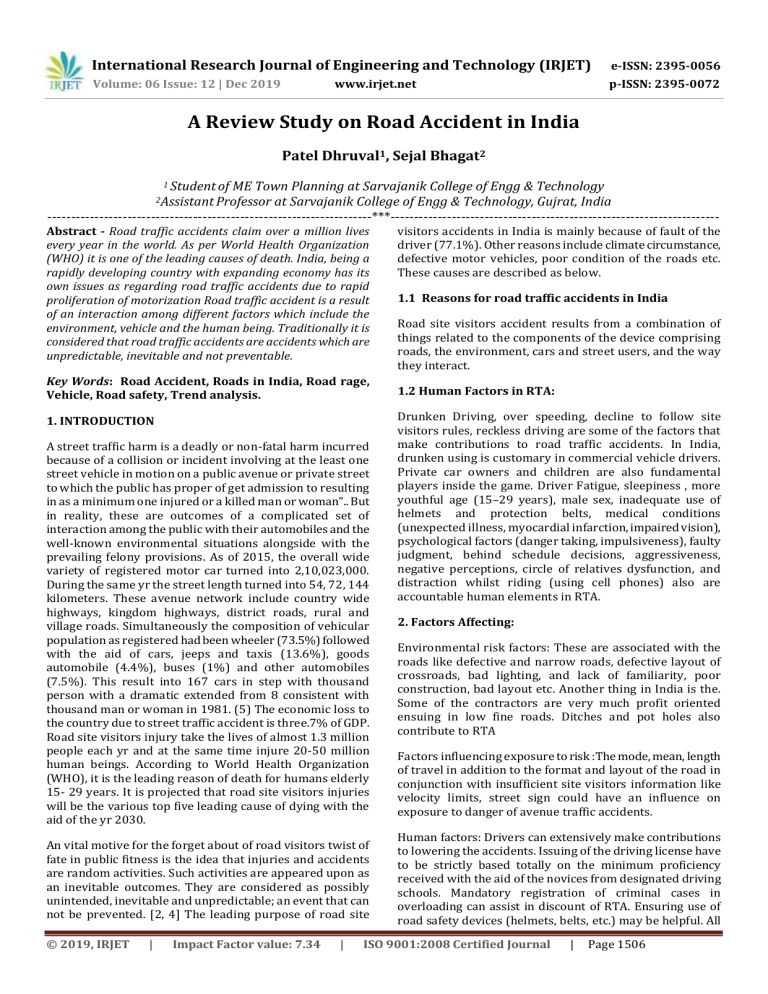
International Research Journal of Engineering and Technology (IRJET) e-ISSN: 2395-0056 Volume: 06 Issue: 12 | Dec 2019 p-ISSN: 2395-0072 www.irjet.net A Review Study on Road Accident in India Patel Dhruval1, Sejal Bhagat2 1 Student of ME Town Planning at Sarvajanik College of Engg & Technology at Sarvajanik College of Engg & Technology, Gujrat, India ---------------------------------------------------------------------***---------------------------------------------------------------------2Assistant Professor Abstract - Road traffic accidents claim over a million lives every year in the world. As per World Health Organization (WHO) it is one of the leading causes of death. India, being a rapidly developing country with expanding economy has its own issues as regarding road traffic accidents due to rapid proliferation of motorization Road traffic accident is a result of an interaction among different factors which include the environment, vehicle and the human being. Traditionally it is considered that road traffic accidents are accidents which are unpredictable, inevitable and not preventable. Key Words: Road Accident, Roads in India, Road rage, Vehicle, Road safety, Trend analysis. 1. INTRODUCTION A street traffic harm is a deadly or non-fatal harm incurred because of a collision or incident involving at the least one street vehicle in motion on a public avenue or private street to which the public has proper of get admission to resulting in as a minimum one injured or a killed man or woman”.. But in reality, these are outcomes of a complicated set of interaction among the public with their automobiles and the well-known environmental situations alongside with the prevailing felony provisions. As of 2015, the overall wide variety of registered motor car turned into 2,10,023,000. During the same yr the street length turned into 54, 72, 144 kilometers. These avenue network include country wide highways, kingdom highways, district roads, rural and village roads. Simultaneously the composition of vehicular population as registered had been wheeler (73.5%) followed with the aid of cars, jeeps and taxis (13.6%), goods automobile (4.4%), buses (1%) and other automobiles (7.5%). This result into 167 cars in step with thousand person with a dramatic extended from 8 consistent with thousand man or woman in 1981. (5) The economic loss to the country due to street traffic accident is three.7% of GDP. Road site visitors injury take the lives of almost 1.3 million people each yr and at the same time injure 20-50 million human beings. According to World Health Organization (WHO), it is the leading reason of death for humans elderly 15- 29 years. It is projected that road site visitors injuries will be the various top five leading cause of dying with the aid of the yr 2030. An vital motive for the forget about of road visitors twist of fate in public fitness is the idea that injuries and accidents are random activities. Such activities are appeared upon as an inevitable outcomes. They are considered as possibly unintended, inevitable and unpredictable; an event that can not be prevented. [2, 4] The leading purpose of road site © 2019, IRJET | Impact Factor value: 7.34 | visitors accidents in India is mainly because of fault of the driver (77.1%). Other reasons include climate circumstance, defective motor vehicles, poor condition of the roads etc. These causes are described as below. 1.1 Reasons for road traffic accidents in India Road site visitors accident results from a combination of things related to the components of the device comprising roads, the environment, cars and street users, and the way they interact. 1.2 Human Factors in RTA: Drunken Driving, over speeding, decline to follow site visitors rules, reckless driving are some of the factors that make contributions to road traffic accidents. In India, drunken using is customary in commercial vehicle drivers. Private car owners and children are also fundamental players inside the game. Driver Fatigue, sleepiness , more youthful age (15–29 years), male sex, inadequate use of helmets and protection belts, medical conditions (unexpected illness, myocardial infarction, impaired vision), psychological factors (danger taking, impulsiveness), faulty judgment, behind schedule decisions, aggressiveness, negative perceptions, circle of relatives dysfunction, and distraction whilst riding (using cell phones) also are accountable human elements in RTA. 2. Factors Affecting: Environmental risk factors: These are associated with the roads like defective and narrow roads, defective layout of crossroads, bad lighting, and lack of familiarity, poor construction, bad layout etc. Another thing in India is the. Some of the contractors are very much profit oriented ensuing in low fine roads. Ditches and pot holes also contribute to RTA Factors influencing exposure to risk :The mode, mean, length of travel in addition to the format and layout of the road in conjunction with insufficient site visitors information like velocity limits, street sign could have an influence on exposure to danger of avenue traffic accidents. Human factors: Drivers can extensively make contributions to lowering the accidents. Issuing of the driving license have to be strictly based totally on the minimum proficiency received with the aid of the novices from designated driving schools. Mandatory registration of criminal cases in overloading can assist in discount of RTA. Ensuring use of road safety devices (helmets, belts, etc.) may be helpful. All ISO 9001:2008 Certified Journal | Page 1506 International Research Journal of Engineering and Technology (IRJET) e-ISSN: 2395-0056 Volume: 06 Issue: 12 | Dec 2019 p-ISSN: 2395-0072 www.irjet.net drivers need to be well trained and must own a valid driving license. Education of the drivers and visiting public about visitors rules must be undertaken. There ought to be periodic medical checkup especially imaginative and prescient and listening to for the drivers. Indiscriminate honking is to be avoided. There need to be stringent checking for overloading.. Overcrowded passenger vehicles must culminate in cancellation of permits. There is a want for a National Accident Relief Policy to make certain: activate relief, free trauma care, training of police, teachers, paramedics etc. Rules for compulsory sporting of helmets via wheelers and seat belts with the aid of 4 wheelers should be implemented. Traffic rules ought to be strictly enforced through the concerned authorities. Removal of stray animals like cattle and removal of encroachments on footpath and street margins will enable clean flow of traffic. Preventing haphazard parking of motors on busy roads and intersections will make certain unfastened flow of visitors Environmental elements or Condition of roads: Roads must be nicely maintained with frequent relaying of road surfaces and markings of road safety signs. Provide proper footpaths for pedestrians and pedestrian crossings at intersections. Provide separate lanes for slow shifting and speedy shifting vehicles. Roads and junctions should be extensive and nicelylit in order that visibility is good. Vehicles: Well-maintained motors with properly breaks, lighting, tyres etc. Will reduce accidents. Older motors and exceedingly polluting automobiles need to be phased out. Vehicles need to be provided with seat belts and other necessary protection provisions like airbags. 3. CONCLUSION Road traffic injury take the lives of nearly 1.3 million people every year and at the same time injured 20-50 million people globally. India, being a rapidly developing country has one of the highest motorization growth rate which is accompanied by rapid expansion in road networks and urbanization. Consequently the country is faced with various issues and impacts on road traffic accidents and road safety level. It takes a heavy financial toll on the economy over and above the mortality and morbidity associated with road traffic accidents. Road traffic accidents are predictable and preventable. For it understanding the different factors leading to RTA is a must. Strict implementation of traffic rules and stringent punishments alone will not solve the persisting problem. Change in the mind set of riders and drivers and road users realizing their responsibilities alone will bring about a change. It requires strong political commitment and multipronged strategies to address the current demands and needs of six E's of road safety such as education, engineering (roads), engineering (vehicles), enforcement, emergency care and enactment. We all have a role in preventing RTA. REFERENCES 1. Thokchom Shantajit, Chirom Ranjeev Kumar, Quazi Syed Zahiruddin. Road traffic accidents in India: An overview. Int. j. clin. biomed. res. 2018;4(4): 36-38. 2. Sharma SM. Road Traffic Accidents in India. Int J Adv Integ Med Sci 2016; 1(2): 57-64. 3. Risk factors for road traffic injuries, Training manual. 4. Decade of Action for Road Safety 2011–2020 Saving millions of lives. WHO 5. Peden MM, World report on road traffic injury prevention: WHO; 2004. 217. 6. Expert committee on auto fuel policy. Urban road traffic and air pollu- tion in major cities. Volume 1: pp.1-395. New Delhi, Government of India. (2002). 7. CRRI. Annual Report 2007. New Delhi, Central Road Research Insti- tute. (2007). 8. NCRB. Accidental Deaths & Suicides in India - 2007. New Delhi, Na- tional Crime Records Bureau, Ministry of Home Affairs. (2008). 9. Mohan, D., Tsimhoni, O., Sivak, M., & Flannagan, M.J. Road Safety in India: Challenges and Opportunities. UMTRI-2009-1, pp.1-57. Ann Arbor, MI, The University of Michigan Transportation Research Insti- tute. (2009). 10. Gururaj, G. Road traffic injury prevention in India. p.56, pp.1-137. Bangalore, NIMHANS. (2006). 11. Tiwari, G., Mohan D., & Gupta, D.P. Evaluation of Capacity Augmen- tation Projects of National Highways and State Highways. Final re- port. New Delhi, Ministry of Surface Transport, GOI. (2000). 12. Mishra, B.K., Banerji, A.K., & Mohan, D. Two-wheeler injuries in Delhi, India: A study of crash victims hospitalized in a neuro-surgery ward. Accident Analysis & Prevention 16: pp.407-416. (1984). 13. Leaf, W.A. & Preusser, D.F. Literature Review on Vehicle Travel Speeds and Pedestrian Injuries. DOT HS 809 021. pp.1-54. Washing- ton, D.C., National Highway Traffic Safety Administration, U.S. Department of Transportation. (1999). 14. Koornstra, M. Prediction of traffic fatalities and prospects for mobility becoming sustainable-safe. “Sadhna - Academy Proceedings in En- gineering Sciences” 32: pp. 365-396. (2007). 15. Kumar, R.P., Venkatramayya, V., & Kashinath, T. Macro level study of road accidents on Dindigul- © 2019, IRJET | Impact Factor value: 7.34 | ISO 9001:2008 Certified Journal | Page 1507 International Research Journal of Engineering and Technology (IRJET) e-ISSN: 2395-0056 Volume: 06 Issue: 12 | Dec 2019 p-ISSN: 2395-0072 www.irjet.net Palani section of NH-209. “Indian High- ways” 32: pp.31-38. (2004). 16. Saija, K.K. & Patel, C.D. Micro level study of accidents on NH-8 pass- ing through Valsad District. “Indian Highways” 30: pp.43-51. (2002). 17. Saija, K.K., Patel, C.D., & Sureja, G.K. Spectrum analysis of road ac- cidents. “Indian Highways” 28: pp.29-41. (2000). 18. Shrinivas, P.L.L. Studies undertaken to identify critical causes of ac- cidents in the highways of Tamil Nadu. “Indian Highways” 31: pp.11- 22. (2004). 19. Shaheem, S., Mohammed, K.M.S., & Rajeevan. Evaluation of cost effectiveness of improvements of accident prone locations on NH-47 in Kerala state. “Indian Highways” 34: pp.35-46. (2006). 20. Cropper, M.L. & Kopits, E. Traffic Fatalities and Economic Growth. “World Bank Policy Research Working Paper” 3035: pp.1-42. Wash- ington D.C., World Bank. (2003). © 2019, IRJET | Impact Factor value: 7.34 | ISO 9001:2008 Certified Journal | Page 1508
